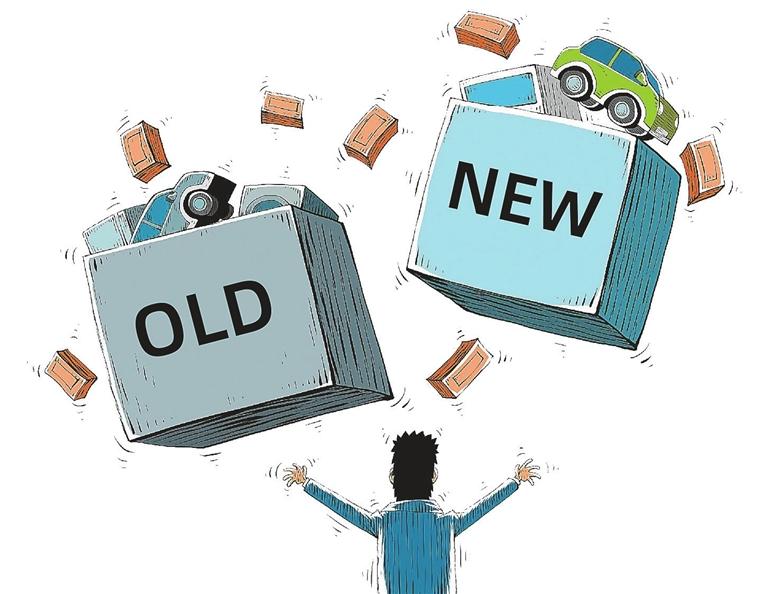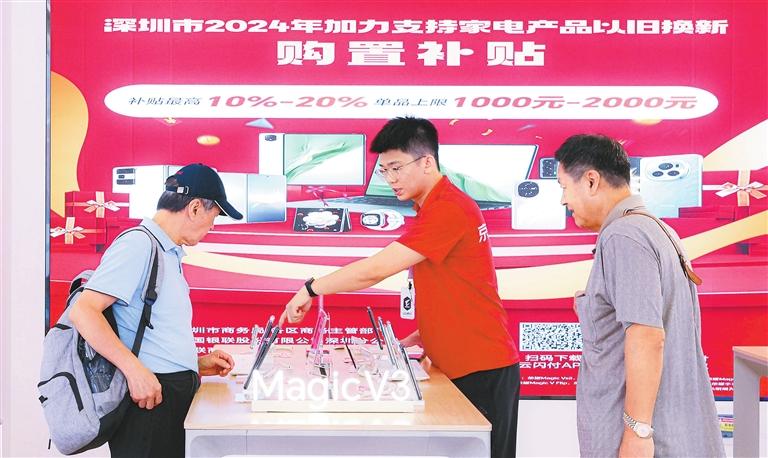



Zhang Yu JeniZhang13@163.com THE Shenzhen Municipal Commerce Bureau released new guidelines for trading in electric bicycles (often referred to as mopeds or electric scooters) Sunday, outlining subsidy amounts, eligibility criteria, standards, and application processes for individuals looking to swap their old electric bicycles for newer models. This initiative is the city’s latest step in advancing trade-in policies across diverse sectors, including automobiles, home appliances, and residential renovations. By leveraging a mix of governmental initiatives and market-driven incentives, Shenzhen has enacted a suite of policies designed to spur trade-ins of used products this year. The government is offering subsidies to both consumers and businesses involved in trade-in programs, effectively lowering the cost of new purchases and enhancing their appeal. Moreover, tax breaks are being extended to companies that participate in the recycling of used products. On May 31, Shenzhen launched a raft of measures to encourage equipment upgrades and boost consumer spending, following the State Council’s release of an action plan in March that aimed to initiate large-scale equipment upgrades and trade-ins of consumer goods. In September, the city government expanded its trade-in policies to encompass multiple sectors, announcing the allocation of ultra-long special treasury bonds to support the replacement of old consumer goods with new ones. Boosting consumer spending The policies have had an immediate impact on consumer spending. By offering substantial discounts on new purchases in exchange for used devices, the program has made it more affordable for consumers to upgrade to the latest technology, leading to a surge in sales across various retail sectors in Shenzhen. Chi Weiguo, deputy director-general of the city’s commerce bureau, announced at a press conference Sept. 12 that the city had initiated its first round of consumer goods purchase subsidies from May to August. During this period, 453,000 home appliances and 27,000 cars were purchased with subsidies totaling 480 million yuan (US$68.39 million), benefiting over 300,000 consumers. Following the implementation of an enhanced consumer goods trade-in policy in Shenzhen on Sept. 6, the range of products eligible for trade-in expanded. The subsidy ratio also increased and now covers eight key areas, including cars, household appliances, and home renovations. Data reveal that from Sept. 6 to 17, more than 79,000 home appliances were sold in the city, driving sales to approximately 420 million yuan. The number of applications for car replacement subsidies reached 4,700, with total subsidies reaching 63.5 million yuan and sales exceeding 1.28 billion yuan. During the Mid-Autumn Festival holiday from Sept. 15 to 17, the average daily number of consumers in Shenzhen purchasing home appliances through trade-ins reached 30,000, with sales revenue nearing 200 million yuan, according to statistics. “Since the introduction of the consumer goods trade-in policy last month, we’ve observed a notable increase in store traffic and sales,” said Peng Jun, general manager of a Suning.com store in Shenzhen. Suning, an online and brick-and-mortar retail store for consumer electronics and home appliances, saw significant sales growth for various products during the Mid-Autumn Festival holiday, with computer sales rising by over 300% compared to the previous month. Suning’s Shenzhen stores experienced a year-on-year sales growth of 128% during the first two days of the National Day holiday. Notably, mobile phone sales increased by 161.66%, cleaning robots by 238.22%, and computers by 89.35%. Chinese e-commerce giant JD.com’s flagship store in Huaqiangbei, Futian District, saw foot traffic surge to over 30,000 between Oct. 1 and 5, a 200% increase compared to the same period last year, according to the store’s manager. Sales of traditional home appliances were particularly robust, accounting for 60% of total sales, with vacuum cleaners within the subsidy scope seeing a significant sales boost. “The discount is quite substantial. I saved around 1,500 yuan by trading in my phone,” said a resident surnamed Wang, who purchased a new phone during the National Day holiday. The Shenzhen October International Auto Show, held from Oct. 1 to 5, also reached new heights in foot traffic and sales this year, driven by the trade-in policy. “Combined with the discounts offered by various car brands at the auto show, the trade-in policy has clearly fueled a surge in car buying,” commented Wang Zhen, the auto show’s project manager. By noon on the auto show’s final day, overall foot traffic had exceeded 400,000, with on-site car transactions surpassing 17,000 and total spending on cars exceeding 4 billion yuan. Trade-in subsidies bolster economic vigor The trade-in model represents a win-win scenario for the economy, offering consumers the chance to upgrade goods while infusing fresh momentum into economic growth. Shenzhen’s trade-in policies not only enhance subsidy levels but also focus on consumer preferences by including greener, more energy-efficient, intelligent, and premium products within the subsidy framework. According to Qin Shijie, a senior official with the city’s development and reform commission, Shenzhen’s trade-in policies, which align with national policy directives and objectives, have undergone further refinement and adjustment in the areas of subsidy scope, standards, and duration. “These modifications aim to comprehensively unlock and sustainably unleash the consumer spending potential inherent within the city,” Qin noted. In the realm of consumer electronics and home appliances, Shenzhen offers a subsidy rate as high as 20% for top-tier energy-efficient appliances. Tailored to consumer trends, the city has expanded the trade-in programs to include six new categories, including consumer drones, robots, 3C servers, projectors, smart sports equipment, and coffee machines. “The policies incentivize consumers to exchange the old for the new with tangible financial benefits, which not only delivers substantial advantages to citizens but also provides critical support for the overall enhancement of the consumer market,” explained Zheng Tiancheng, deputy director of the Enterprise and Market Research Center at the China Development Institute. Zheng noted that the government’s generous subsidies for eco-friendly and smart products will not only propel consumer spending and enhance the quality of life for the general public, but also drive the transformation of the entire industry chain. He believes that this, in turn, stimulates innovation in production and manufacturing, accelerates the modernization of production equipment, and establishes a positive cycle of personal consumption and business investment. | 
